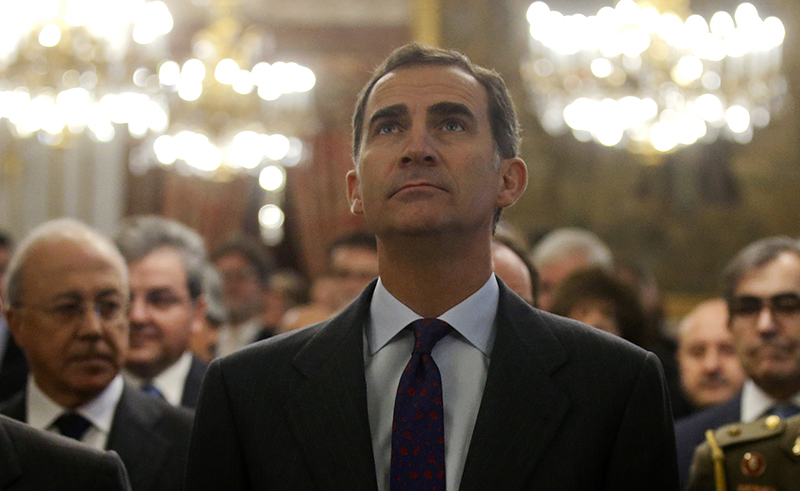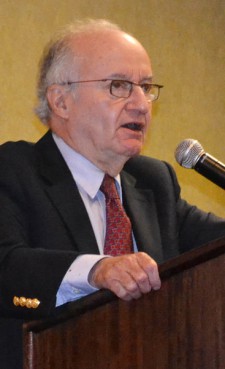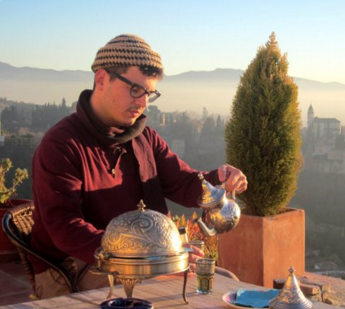
Spain’s King Felipe attends a ceremony celebrating a law through which Sephardic Jews who can prove that they are descendants of the Sephardic Jews expelled from Spain in 1492 and who maintain a special relationship with Spain can apply for Spanish citizenship, at the Royal Palace in Madrid, on Nov. 30, 2015. Photo courtesy of REUTERS/Andrea Comas
*Editors: This photo may only be republished with RNS-SPANISH-RABBI, originally transmitted on Feb. 24, 2016.
(RNS) On March 31, 1492, King Ferdinand and Queen Isabella of Spain issued an edict, decreeing “the departure of all Jews from our kingdoms with instructions that they should never return.” That included some Jewish families that had lived on the Iberian Peninsula for more than 1,000 years.
Now, more than five centuries later, Jewish life is blossoming again. One remarkable sign of that is 34-year-old Haim Casas, who, when he completes his rabbinic training at the Leo Baeck College in London next year, will become the first Spanish-born rabbi since the expulsion.
Casas grew up in a Catholic family in Cordoba, the birthplace of Moses Maimonides, the famed medieval rabbi, physician and philosopher. As a teen-ager, Casas felt a tug of history and he became attracted to Judaism and Jewish history. He believes he descends from “converso” Jews, who centuries ago became outwardly Catholic but observed truncated forms of Jewish rituals and liturgy in secret.
“It’s just a memory, a feeling, a connection you have,” he said, explaining the attraction to Judaism.
Later, while doing Holocaust research, Casas discovered the name “Casas” on a list of victims at the Auschwitz death camp, further strengthening that sense of connection.
It’s estimated that as a result of the expulsion edict in 1492, up to 200,000 Jews fled the country for other parts of Europe, North Africa, the Americas and the Middle East.
#DvarTorah Parashat Vayeshev by Student Rabbi Haim Casas @Haimcasas Shabbat Shalom. https://t.co/Nq0Uvv7976 pic.twitter.com/bfgJFC7xO5
— Leo Baeck College (@LeoBaeckCollege) December 3, 2015
RELATED STORY: Spain passes law granting dual nationality to Sephardic Jews
It was a terrifyingly traumatic experience for the Sephardic (Sepharad is the Hebrew word for “Spain”) community and remains an indelible and lachrymose part of the Jewish people’s collective memory bank.
The edict also threatened anyone who aided or hid any Jews who refused to leave, and even the conversos themselves. Many were suspected of falsely converting and sentenced to death under “limpieza de sangre,” or blood purity judgments, which were also used by opportunists to carry out vendettas against people who had no Jewish ancestry.
It happened during Spain’s Golden Age, but many historians trace the decline of the once formidable Spanish empire to the expulsion of its Jews and later its Muslim population in 1609.
Exactly 500 years after the infamous 1492 edict, on March 31, 1992, King Juan Carlos of Spain and Chaim Herzog, Israel’s president, prayed together in a Madrid synagogue. “We cannot change the past. But we can learn its lessons and thus assure a better future for ourselves and humanity,” the king said by way of apology. “Never again will hate and intolerance provoke desolation and exile.”
Last year the Madrid government announced that descendants of expelled Jews who have a “special link” to Spain could apply for citizenship: another act of atonement for the “historic mistake” of 1492.
It’s not clear how many Sephardic Jews will take up that offer and join a community now estimated to number 45,000, made up mostly of Jews who fled Morocco during the Arab-Israeli wars.
RELATED STORY: My top 10 Jewish news stories of 2015 (COMMENTARY)
Experts estimate there are 3.5 million Jews throughout the world with family links to Spain, but Casas doubts that many of them will opt for Spanish citizenship.
“As important as the law is, a lot depends on the Spanish economy — even for Jews who may wish to leave (Spanish-speaking) South America,” he said.
“For me, the challenge and mission is how to be welcoming to both the Jews already in Spain, as well as those who do come. It’s also about welcoming the huge numbers of people who are not Jewish but who are interested in Judaism,” Casas said.
Despite his early interest in Jews and Judaism, Casas didn’t think of becoming a rabbi: “I always saw clergy and the establishment as part of the problem, not the solution.” But in time, he underwent a formal Jewish conversion ceremony and began his rabbinical studies.
As a seminary student, he receives “on the job” training serving congregations in Switzerland, France and Spain. Casas says that when he returns as an ordained rabbi to his home country, “I envision educational programs and publications toward recovering Jewish memories.”

Rabbi A. James Rudin is the American Jewish Committee’s senior interreligious adviser. He can be reached at jamesrudin.com. His latest book is “Pillar of Fire: The Biography of Rabbi Stephen S. Wise,” published by Texas Tech University Press. RNS photo courtesy of Rabbi A. James Rudin
He is eager to revive Jewish life in Spain with a positive future, lest it become a “Sephardic Disneyland,” a charming tourist destination that focuses on the past.
Being Spanish, the young future rabbi plans to blend into his worship services traditional Jewish liturgy and rituals with flamenco music along with the Sephardic Ladino language.
“The idea is for Spanish Jewry to preserve its heritage, but at the same time to become again a dynamic, creative force in the Jewish world,” he said.
Mazel tov and buena suerte!
(Rabbi A. James Rudin is the American Jewish Committee’s senior interreligious adviser. His latest book is “Pillar of Fire: The Biography of Rabbi Stephen S. Wise,” published by Texas Tech University Press. He can be reached at jamesrudin.com)





